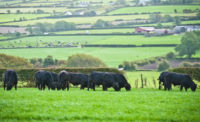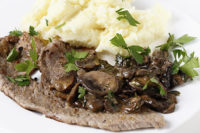High Hopes for Veal and Lamb
Veal and lamb get a boost from heightened efforts to increase consumer awareness.
Once associated with only high-end fare, veal and lamb are overhauling their images and strengthening their presence to attract a broader range of consumers. The veal industry this spring announced a major goal of expanding veal’s availability in casual-dining restaurants, for example.
Veal consumption is currently weighted heavily toward an older demographic, and the industry is aggressively seeking ways to appeal to younger consumers. One of the challenges in achieving this goal is to make sure veal is on the menu at more casual-dining restaurants, affirms Michael Mosner, a veal packer from the Bronx, NY, and chairman of the joint veal committee of the National Cattlemen’s Beef Association (NCBA).
“With families being on the move, both parents working, and children going to all sorts of activities, it’s hard for them to find time for dinner at home,” Mosner continues. “And the casual-dining restaurant is the venue where most young families are going.”
Mosner notes that the veal industry is experiencing high prices for dairy calves, feed, and other operating costs, making it even more critical for the industry to expand exposure and consumer demand for veal. As part of the industry’s efforts, checkoff-funded programs will promote veal to casual-theme restaurants by working with celebrity chefs to develop recipes.
| Annual Lamb and Mutton Forecasts | |||||||
| 2001 | 2002 | 2003 | 2004 | 2005 | 2006 | ||
| Production (millions lb.) | 223 | 219 | 199 | 195 | 193 | 201 | |
| Per capita consumption (retail lb.) | 1.1 | 1.2 | 1.2 | 1.1 | 1.2 | 1.2 | |
| Imports (millions lb.) | 146 | 162 | 168 | 181 | 173 | 175 | |
| *Per capita meat consumption data are revised, incorporating a new population series from the Commerce Department’s Bureau of Economic Analysis based on the 2000 Census. Source: World Agricultural Supply and Demand Estimates and Supporting Materials Published in Livestock, Dairy, and Poultry Outlook, http://www.ers.usda.gov/publications/ldp/ | |||||||
For its part, the American Lamb Board (ALB) in December 2004 launched a new television advertising campaign, “American Lamb. From American Land,” to communicate the message that American lamb is simple to prepare, pure, high-quality protein that is distinct from imported lamb. Aired on the TV Food Network, the commercial is said to “convey the pride and stewardship of American lamb producers and tie domestic lamb back to the heritage of America,” notes Spence Rule, chairman of the ALB.
Texas A&M University also this year released promising news from its economic study, “Is the Return Greater than the Investment for the American Lamb Industry?” The study’s findings indicate that ALB’s promotional efforts have successfully increased demand for lamb. During the time in which the lamb checkoff has promoted American lamb (2002-2004), about 10 additional pounds of lamb per dollar spent were consumed, translating into $50 additional dollars in lamb sales.
New consumer-friendly products
Augmenting the veal and lamb industry’s promotional efforts are a number of convenient, consumer-friendly product introductions. Mountain States Rosen (MSR), Bronx, NY, and Greeley, CO, for example, recently introduced its line of Cedar Springs microwaveable pre-cooked lamb and veal products. The innovative new products include lamb meatballs, veal patties, lamb and veal sausage, and baby-back lamb ribs — cooked or raw. The packaging includes cooking information and references the company’s Web site, www.usalamb.com, which contains lamb recipes and other information. Each Cedar Springs product taste profile was developed internally and fine-tuned through feedback from chefs, MSR’s growers, and internal tastings.
Meanwhile, South Holland, IL-based Brown Packing Company’s new, all-natural Dutch Valley Veal Hot (Spicy) Veal Italian Sausage, Traditional Hearty Veal Bratwurst, Savory Sun-Dried Tomato Veal Sausage, and Classic Veal Italian Sausage – each packaged in its own one-pound retail-ready film-overlam tray – capitalizes on consumers’ love of sausage products. NP





Report Abusive Comment